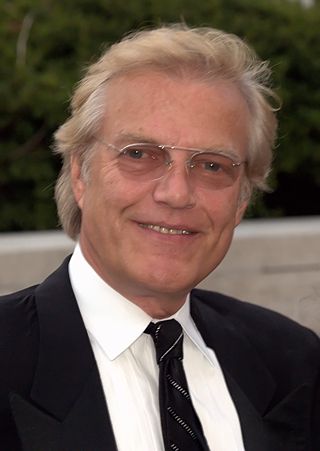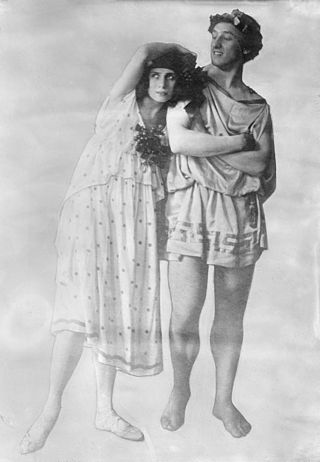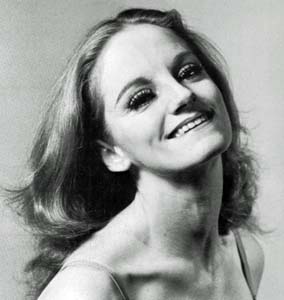
New York City Ballet (NYCB) is a ballet company founded in 1948 by choreographer George Balanchine and Lincoln Kirstein. Balanchine and Jerome Robbins are considered the founding choreographers of the company. Léon Barzin was the company's first music director. City Ballet grew out of earlier troupes: the Producing Company of the School of American Ballet, 1934; the American Ballet, 1935, and Ballet Caravan, 1936, which merged into American Ballet Caravan, 1941; and directly from the Ballet Society, 1946.

Peter Martins is a Danish former ballet dancer and choreographer. Martins was a principal dancer with the Royal Danish Ballet and with the New York City Ballet, where he joined George Balanchine, Jerome Robbins, and John Taras as balletmaster in 1981. He retired from dancing in 1983, having achieved the rank of danseur noble, becoming Co-Ballet Master-In-Chief with Robbins. From 1990 until January 2018, he was responsible for artistic leadership of City Ballet.
John Taras was an American ballet master, repetiteur, and choreographer.
Romeo + Juliet, as it is displayed in print, is a ballet by New York City Ballet balletmaster-in-chief Peter Martins to Sergei Prokofiev's Romeo and Juliet (1934–1940). The premiere took place on Tuesday, 1 May 2007 at the New York State Theater, Lincoln Center.
Noah and the Flood is a ballet choreographed by George Balanchine, co-founder and balletmaster of the New York City Ballet, and Jacques d'Amboise to Stravinsky's The Flood (1962). The premiere took place June 11, 1982, at the New York State Theater, Lincoln Center. The text was chosen and arranged by Robert Craft from Genesis, the Te Deum and Sanctus hymns, and the 15th century York and Chester miracle plays.
Sean Lavery was a former principal dancer, balletmaster, and assistant to the balletmaster in chief at New York City Ballet. He was a répétiteur for the George Balanchine Trust and a former faculty member at the School of American Ballet.
Octet is a ballet made by New York City Ballet balletmaster in chief Peter Martins to Mendelssohn's Octet in E-flat major (1825). The premiere took place November 14, 2003 at the Royal Danish Ballet, Copenhagen; the NYCB premiere was November 23, 2004, at the New York State Theater, Lincoln Center.
X–Ray is a ballet made by New York City Ballet balletmaster in chief Peter Martins to John Adams' 1994 Violin Concerto, commissioned jointly by the Minnesota Orchestra and City Ballet. The ballet premiere took place Tuesday, November 22, 1994, at the New York State Theater, Lincoln Center; since June 1995 it has been performed as the third movement of Martins' Adams Violin Concerto ballet.
Square Dance is a ballet made by New York City Ballet co-founder and balletmaster George Balanchine to Antonio Vivaldi's Concerto Grosso in B minor and the first movement of his Concerto Grosso in E major, Op. 3, nos. 10 and 12, respectively; in 1976 he added Arcangelo Corelli's Sarabanda, Badinerie e Giga, second and third movements. The premiere took place on November 21, 1957, at City Center of Music and Drama, New York, with lighting by Nananne Porcher. The original version placed the musicians on stage with a square dance caller calling the steps; from its 1976 revival the caller was eliminated, the orchestra placed in the pit, and a solo added for the premier danseur to the Corelli Sarabanda. The Pacific Northwest Ballet restored the caller for one performance at the 2007 Vail International Dance Festival.
Watermill is a ballet choreographed by Jerome Robbins when he was balletmaster at the New York City Ballet and set to a musical piece written a year earlier by Teiji Ito, with costumes by Patricia Zipprodt, lighting by Jennifer Tipton and décor by Robbins in association with Davie Reppa. The ballet premiered on Thursday, February 3, 1972, at the New York State Theater, Lincoln Center.
I'm Old Fashioned (The Astaire Variations) is a ballet made by New York City Ballet balletmaster Jerome Robbins to Morton Gould's adaptation of a theme by Jerome Kern, “I'm Old Fashioned”, to a Fred Astaire and Rita Hayworth sequence from the film You Were Never Lovelier. The premiere took place on Thursday, June 16, 1983, at New York State Theater, Lincoln Center. It was titled Variations on "I'm Old Fashioned" at its first performance, but the name was truncated to its current form the following week.
Ragtime (II) is the third ballet made by New York City Ballet's co-founder and balletmaster George Balanchine to Igor Stravinsky's Ragtime for Eleven Instruments (1918). The premiere took place on July 15, 1966, at Philharmonic Hall, New York. The first City Ballet performance was on January 17, 1967, at New York State Theater, Lincoln Center. The previous ballets made to Stravinsky's Ragtime were Ragtime (I) for City Ballet in 1960 and one of a number of "informal little things" made in St. Petersburg in 1922.
Ragtime (I) is the second of three ballets made by New York City Ballet's co-founder and balletmaster George Balanchine to Igor Stravinsky's 1918 Ragtime for Eleven Instruments; with scenery by Robert Drew previously used for Lew Christensen's 1947 work for Ballet Society, Blackface; costumes by Karinska and lighting by David Hays. The premiere took place on December 7, 1960, at City Center of Music and Drama, conducted by Robert Irving, as part of a quartet of works titled Jazz Concert, together with dances by Todd Bolender's Creation of the World, Francisco Moncion's Les biches and John Taras' Ebony Concerto. Balanchine's 1966 Ragtime (II) was also made for City Ballet; his previous ballet to Stravinsky's Ragtime was one of a number of "informal little things" made in St. Petersburg in 1922.
Requiem Canticles is a ballet made by New York City Ballet co-founder and balletmaster George Balanchine to eponymous music from 1966 by Igor Stravinsky in memoriam Martin Luther King, Jr. It received a single performance on May 2, 1968, at the New York State Theater, Lincoln Center, conducted by Robert Irving with Margaret Wilson, contralto, and John Ostendorf, bass. Costumes and candelabra were by Rouben Ter-Arutunian and lighting by Ronald Bates, the corps de ballet in long white robes bearing a three-branched candelabra. A lone woman searches among them and at the end a figure in purple representing Martin Luther King, Jr., is raised aloft.
Requiem Canticles is a ballet made for New York City Ballet's Stravinsky Festival by balletmaster Jerome Robbins to eponymous music from 1966 by Igor Stravinsky. The premiere took place June 25, 1972, at the New York State Theater, Lincoln Center.
Monumentum pro Gesualdo is a 1960 arrangement and recomposition by Igor Stravinsky of three madrigals by Carlo Gesualdo. It was composed to commemorate the 400th anniversary of Gesualdo's birth and was intended to complement Stravinsky's similar Tres Sacrae Cantiones. It was premiered on September 27, 1960, at the Venice Biennale, played by the Orchestra del Teatro la Fenice conducted by Stravinsky.
Ronald Bates was an American ballet lighting designer, particularly for the New York City Ballet.
Robert Schumann’s “Davidsbündlertänze” is one of the last major works made by New York City Ballet's founding choreographer and balletmaster-in-chief, George Balanchine. It is set to Robert Schumann's Davidsbündlertänze, Op. 6 (1837). The idea for setting this piano work very likely came from a work created by Robert Joffrey for his own Joffrey Ballet Company, the premier of which took place at the City Center Theater in the late 1970s. Joffrey, in turn, received his inspiration from Jonathan Watts, a protege of Joffrey's and director of the Joffrey apprentice company, who, at the suggestion of pianist Neil Stannard, created a ballet titled Evening Dialogues to this same score. This initial version of the Schumann cycle was featured on tour with the Joffrey second company in the mid 1970a.

Laurent Novikoff or Laurent Novikov, was a Russian ballet dancer who became a citizen of the United States in 1939.

Sally Harrington, known professionally as Sara Leland, was an American ballet dancer and répétiteur. She started her career with the Joffrey Ballet in 1959, and was recruited to join the New York City Ballet by George Balanchine in 1960. She was promoted to principal dancer in 1972, and created roles for both Balanchine and Jerome Robbins.